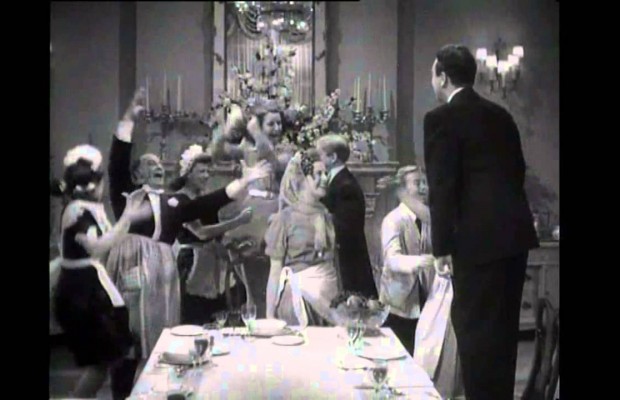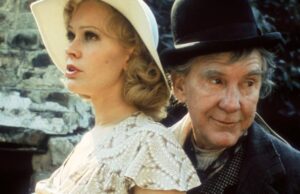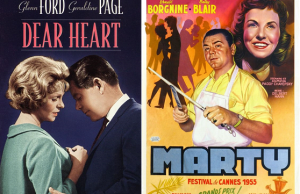Higher and Higher (1943)
By Toronto Film Society on February 14, 2014
Toronto Film Society presented Higher and Higher on Monday, February 3, 2014 in a double bill with Sing, Baby, Sing as part of the Season 66 Monday Night Film Buff Series, Programme 5.
This film’s original advertising tagline–“THE SINATRA SHOW”–clearly shows its main attraction at the time of release. This was the first RKO film for Sinatra, in what was to be a  3-pictgure deal. However, Louis B. Mayer bought out his contract to bring him to MGM, and the remaining two films were never made. With Sinatra in mind, RKO purchased the rights to this moderately successful Rogers and Hart Broadway musical (which had also starred Jack Haley) for $15,000. Frank isn’t top-billed here because RKO’s contacts with Michele Morgan and Jack Haley prevented higher billing. The studio jettisoned all but one of the original Rogers and Hart songs (keeping only “Disgustingly Rich”) and added new ones. The four songs Sinatra sings were specially written by Jimmy McHugh and Harold Adamson to accommodate his singing style. One, “I Couldn’t Sleep a Wink Last Night,” was nominated for an Oscar for Best Song, but lost to Alice Faye’s “You’ll Never Know.”
3-pictgure deal. However, Louis B. Mayer bought out his contract to bring him to MGM, and the remaining two films were never made. With Sinatra in mind, RKO purchased the rights to this moderately successful Rogers and Hart Broadway musical (which had also starred Jack Haley) for $15,000. Frank isn’t top-billed here because RKO’s contacts with Michele Morgan and Jack Haley prevented higher billing. The studio jettisoned all but one of the original Rogers and Hart songs (keeping only “Disgustingly Rich”) and added new ones. The four songs Sinatra sings were specially written by Jimmy McHugh and Harold Adamson to accommodate his singing style. One, “I Couldn’t Sleep a Wink Last Night,” was nominated for an Oscar for Best Song, but lost to Alice Faye’s “You’ll Never Know.”
This was not Sinatra’s film debut–he’d made brief appearances singing in two previous movies–but it does mark the first time he was  given lines and a character to play (admittedly, the character he’s playing here–“Frank Sinatra”–isn’t that much of a stretch). The is the 1940s Sinatra, long before the Rat Pack/”Chairman of the Board” stuff, in the days back when he was a skinny, shy charmer with an amazing voice. This remained his basic screen persona until the 1950s, when his Oscar-winning performance in From Here to Eternity (1953) ushered in much grittier Sinatra roles. These in turn were supplanted by the Swinging ’60s “ring-a-ding-ding” Frank.
given lines and a character to play (admittedly, the character he’s playing here–“Frank Sinatra”–isn’t that much of a stretch). The is the 1940s Sinatra, long before the Rat Pack/”Chairman of the Board” stuff, in the days back when he was a skinny, shy charmer with an amazing voice. This remained his basic screen persona until the 1950s, when his Oscar-winning performance in From Here to Eternity (1953) ushered in much grittier Sinatra roles. These in turn were supplanted by the Swinging ’60s “ring-a-ding-ding” Frank.
Multitalented Sinatra had both strengths and weaknesses as a film actor. He was a very quick study, even able to learn to dance well enough to keep up with Gene Kelly at MGM. But he  was hampered by impatience. By the 1960s, after he’d earned the power to call the shots, not all actors could (or would) work with him. Sinatra (a.k.a. “One-Take-Charlie”) thought rehearsals unnecessary and preferred to wing it in films like Ocean’s Eleven (1960) and Robin and the Seven Hoods (1964). “I’m a performer,” he explained. “I’m better in the first take.” He was always a man of strong opinions, including some harsh ones about his own successes: he never liked the song “Strangers in the Night,” no matter how popular it was, and thought his huge hit “My Way” was “self-serving and indulgent.”
was hampered by impatience. By the 1960s, after he’d earned the power to call the shots, not all actors could (or would) work with him. Sinatra (a.k.a. “One-Take-Charlie”) thought rehearsals unnecessary and preferred to wing it in films like Ocean’s Eleven (1960) and Robin and the Seven Hoods (1964). “I’m a performer,” he explained. “I’m better in the first take.” He was always a man of strong opinions, including some harsh ones about his own successes: he never liked the song “Strangers in the Night,” no matter how popular it was, and thought his huge hit “My Way” was “self-serving and indulgent.”
Like its Broadway predecessor, Higher and Higher suffers from a rather thin script. But it features a group of fine comic actors and performers, able to inject life into it. These include:
 – Leon Errol, a former Broadway actor and director, best remembered in films for the “Mexican Spitfire” series opposite Lupe Velez.
– Leon Errol, a former Broadway actor and director, best remembered in films for the “Mexican Spitfire” series opposite Lupe Velez.
– Blunt, lanky comedienne Mary Wickes, a Broadway veteran, and a great favourite of George S. Kaufman’s. She was immediately in great demand in Hollywood after her feature debut in The Man Who Came to Dinner (1942), and remained so for the rest of her long life. This was her eleventh film in just one year.
 – Lovely Barbara Hale, years before she became familiar on ’50s TV as Perry Mason’s Della Street. Hale became known industry-wide for her screams; her co-star Raymond Burr proudly claimed “She has the best shriek in Hollywood.”
– Lovely Barbara Hale, years before she became familiar on ’50s TV as Perry Mason’s Della Street. Hale became known industry-wide for her screams; her co-star Raymond Burr proudly claimed “She has the best shriek in Hollywood.”
-“Velvet Fog” Mel Torme, who made his movie debut in Higher and Higher, at 18.
– Comic Dane Victor Borge, who made his American film debut in the film.
– Dooley Wilson, familiar as “Sam” from 1942’s Casablanca, who plays the chauffeur.
Notes by Paddy Benham
You may also like...
-
News

Frances Blau
Toronto Film Society | February 27, 2024On Monday, February 26th, 2024, Toronto Film Society lost longtime friend, supporter, and board member Frances Blau. Known for her sense of humour, her love of film, her generosity,...
-
Special Events

Monday Evening Film Noir Double Bill at the Paradise Theatre
Toronto Film Society | July 8, 2024The Toronto Film Society presents a film-noir double feature at one low price! The Window (1949) in a double bill with Black Angel (1946) at the Paradise Theatre on Monday, August...
Programming

Virtual Saturday Night at the Movies
Toronto Film Society | July 20, 2024Toronto Film Society is back in the theatre! However, we’re still pleased to continue to bring you films straight to your home! Beginning Season 73 until now we have...
4-
 Toronto Film Society | July 8, 2024
Toronto Film Society | July 8, 2024
Monday Evening Film Noir Double Bill at the Paradise Theatre
-
 Toronto Film Society | November 6, 2022
Toronto Film Society | November 6, 2022
-
 Toronto Film Society | August 1, 2023
Toronto Film Society | August 1, 2023
Donate to Toronto Film Society – We’re now a Registered Charity!
-
Copyright © 2017 Toronto Film Society.




Leave a Reply